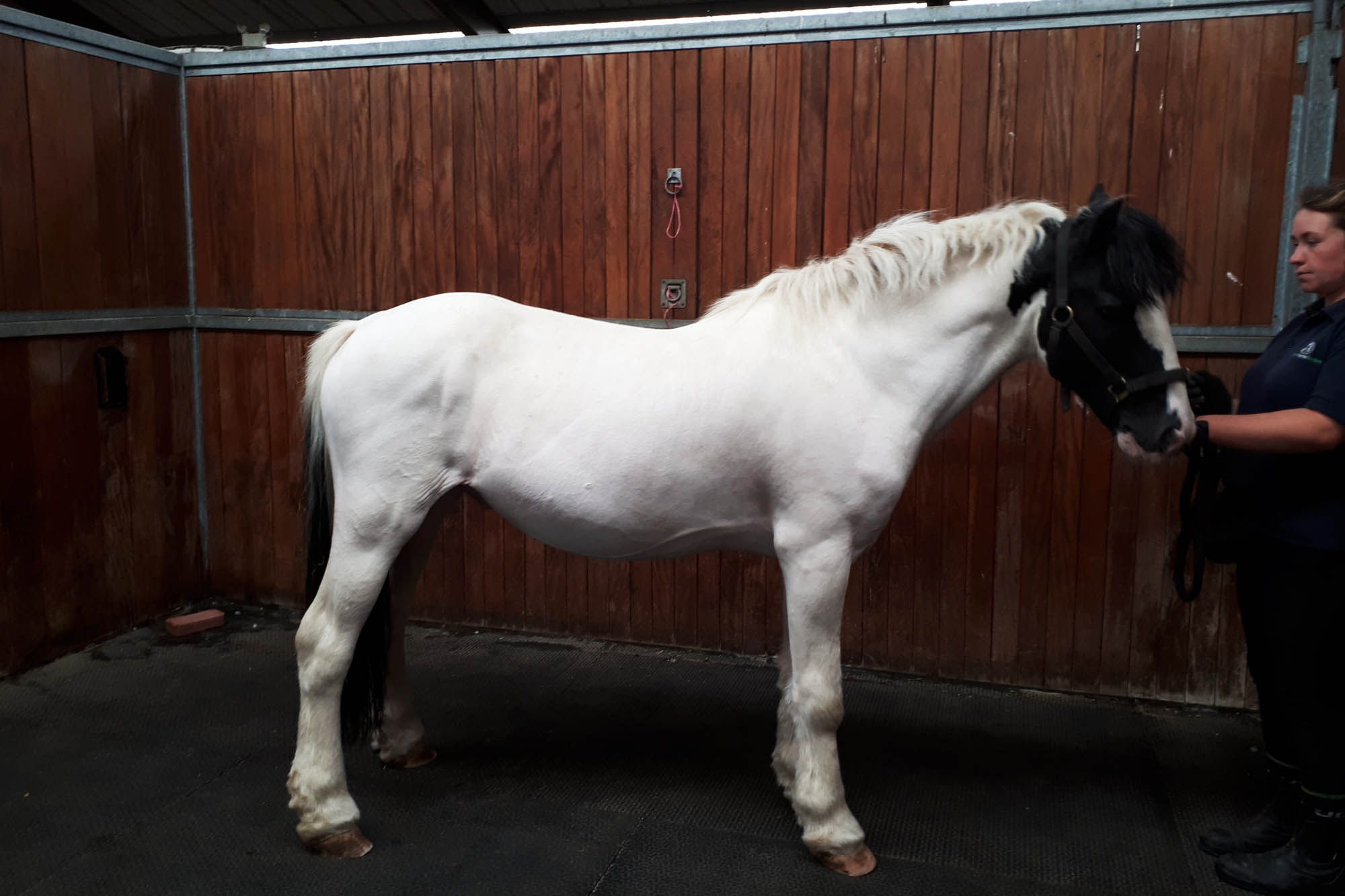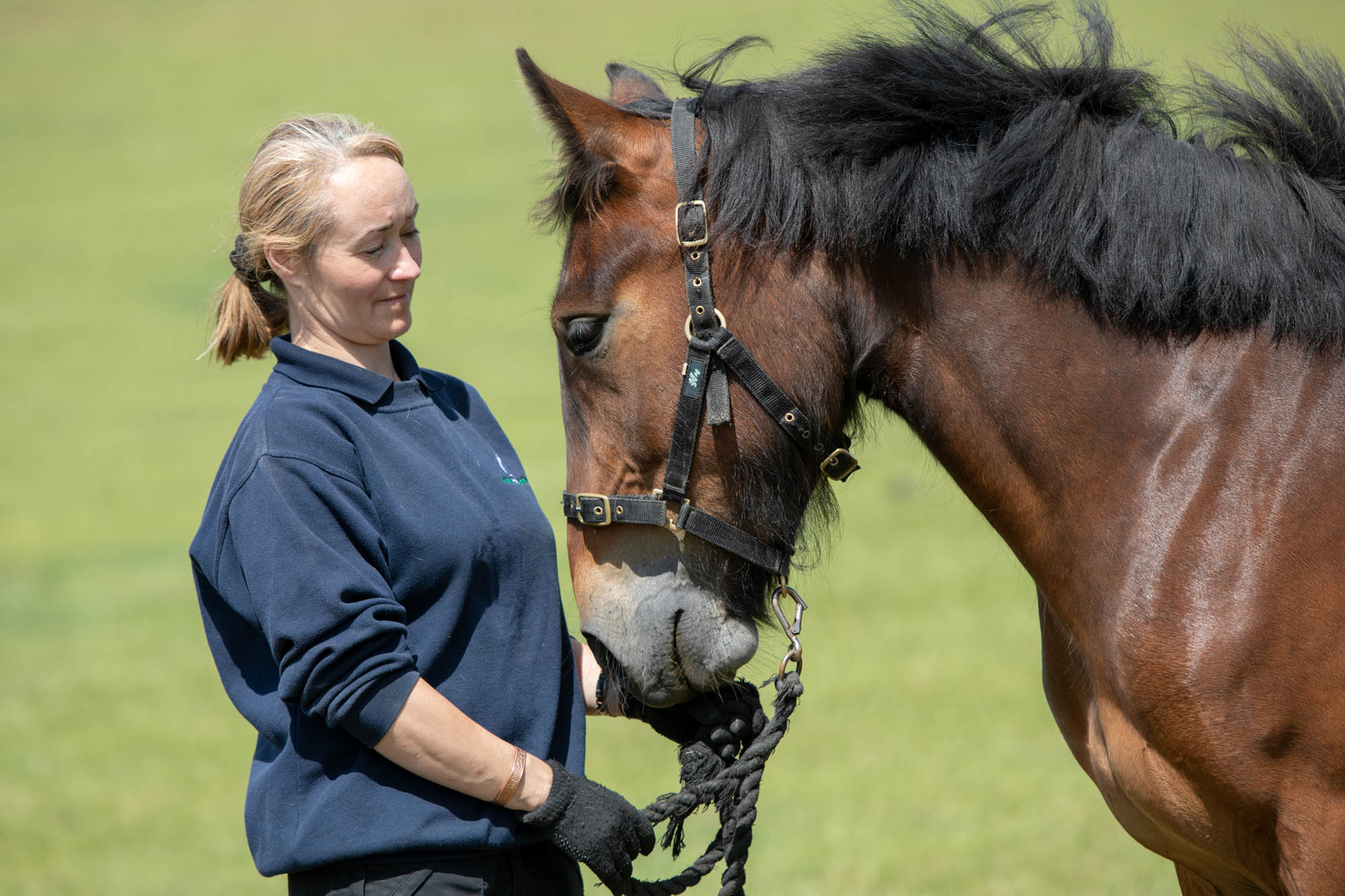Retraining to build trust and increase confidence
We catch up with Belwade Farm groom Kirsty, to find out more about Clover’s story.
Posted on 05/11/2025

From severe malnourishment and disease to treatment that has left them fearful of people, we rescue around 300 horses every year. And every horse, pony, donkey and mule who comes into the care of our rescue and rehoming centres is given their own bespoke rehabilitation plan to help them on their road to recovery and eventually, rehoming.
At Belwade Farm, groom Kirsty Sewell was paired up with 17-year-old Arab cross Clover who she worked with to build trust and increase confidence. Here, Kirsty shares Clover’s story.
Clover came into our care last year with four other horses after their owner was no longer able to provide the care they needed. During her initial assessment it was clear that she was exceptionally needle shy – to the point where the vet or dentist could not approach her and she was at risk of hurting herself trying to avoid treatment. For any horse to be successfully rehabilitated it is important that they can be confident with any treatment, whether it is for routine health care such as vaccinations and sedation for dental checks but also in an emergency to allow for treatment if the horse is in pain.
When it comes to our needle shy horses we often try using a numbing cream to make the experience of having an injection less stressful, but with Clover, and many of our other rescued horses, they start to learn who the vet, farrier and other specialists are, which means that they anticipate what is coming and their apprehension and fear begins even before the needle appears.
I wanted to find a way in which we could desensitise them to the process before the vet visits. I took advice from one of our Welfare Wednesday Webinars where Gemma Pearson talks about how to restrain horses appropriately. In it, she explains how she retrained her horse to like fly spray by using ‘removal reinforcement’. In it she talks about giving the horse a choice so they can stop and start the training. This method teaches horses to stand at a target using positive reinforcement training with the addition of something nice to reward the correct response. Once they know that, the horse can use that as start/stop signals. So, if they touch the target that means start, whenever they stay there, that means keep going but if they move away from the target, that means they want you to stop.
We often use the pressure release technique, which is similar to this but without a target, for example when desensitising a horse to worming. We put the wormer near them and if they keep still the wormer goes away and they are rewarded. Once happy with that stage, the wormer gets closer to the mouth, repeating the release when they are calm, until they allow us to just hold it on their muzzle and so on. You can use this method for most things like clipping and teaching them to hold their feet up. We are always trying to find new ways in which we can keep a calm environment and allow the horses to have more choice, as most have not in the past and that, in turn, has created many of the fears we see when horses in need come in.
For Clover, I created a version of the target and reward system that Gemma talks about in the webinar. All of this was to rebuild her confidence.
I started off by training Clover to touch the target, which in her case was a board, in order to receive food rewards. I then slowly began introducing the same moves around the act of having an injection. If Clover touched the board, I interpreted that as her agreeing to the ‘treatment’. If she didn’t, then I would stop. This allowed her to build trust and not to panic. As Clover became more confident, other grooms tried the same approach with her and with time, patience and care, her confidence returned. It was so wonderful to see.
When it came to Clover’s first injection, we wanted to make sure she had a good experience, so a numbing cream was used to reduce any pain association. This approach worked so well that Clover was able to be sedated for her last dental appointment without the numbing cream and with no stress – and she remained calm with other treatments as well.
Wonderfully, Clover found a new home as a companion in August.
I shared the method we have been working on with Clover’s rehomer, showing her the technique, so she could carry on with the same routine, helping to build Clover’s trust and confidence further. We are delighted that Clover has settled into her new home so well and we have had glowing reports from her rehomer.
When you see how far a horse you have been working with has come, it is so rewarding and it certainly makes all the dedication and hard work worth it. You realise that we are making a difference every single day to their lives to enable them to have a second chance in life.
Across our four rescue and rehoming centres, we follow a whole horse approach during rehabilitation which sees our specialist team including a vet, farrier, equine dentist and our rehabilitation grooms working together to create a tailor-made treatment plan for each horse.
Our team approach continues after rehoming, so the rehomer will work with their own specialists, as well as always being able to access advice from their local Rehoming Officer, the farm teams, and Head Office.
Photo caption: Kirsty mimics the act of giving Clover an injection during training.
Topics
Related Blog Posts

A day with the vet: scans and x-rays
Claire Dickie, Glenda Spooner Farm Centre Manager, describes some of the cases looked at in the course of a vet day.

“So how does Vet Day work then?”
Claire Dickie, Glenda Spooner Farm Centre Manager, gives an overview of how vet day works at our farms.
Recommended News Articles

Birth of first foal from rescued ‘smuggled’ Dover 26 horses
A new beginning at Hall Farm as rescued mare Daisy welcomes foal, Pompey

International coalition of charities brings together Commonwealth vets to tackle working equid welfare
The International Coalition of Working Equids hosted a workshop as part of the 7th Pan Commonwealth Veterinary Conference.

Charities warn owners to exercise caution when finding horses new homes
World Horse Welfare and Retraining of Racehorses highlight opportunities available when finding a horse a new home.
Enjoy reading stories like this?
Join over 65,000 other horse lovers and sign up for our email newsletter

Join over 65,000 other horse lovers and sign up for our email newsletter
Sign me up now